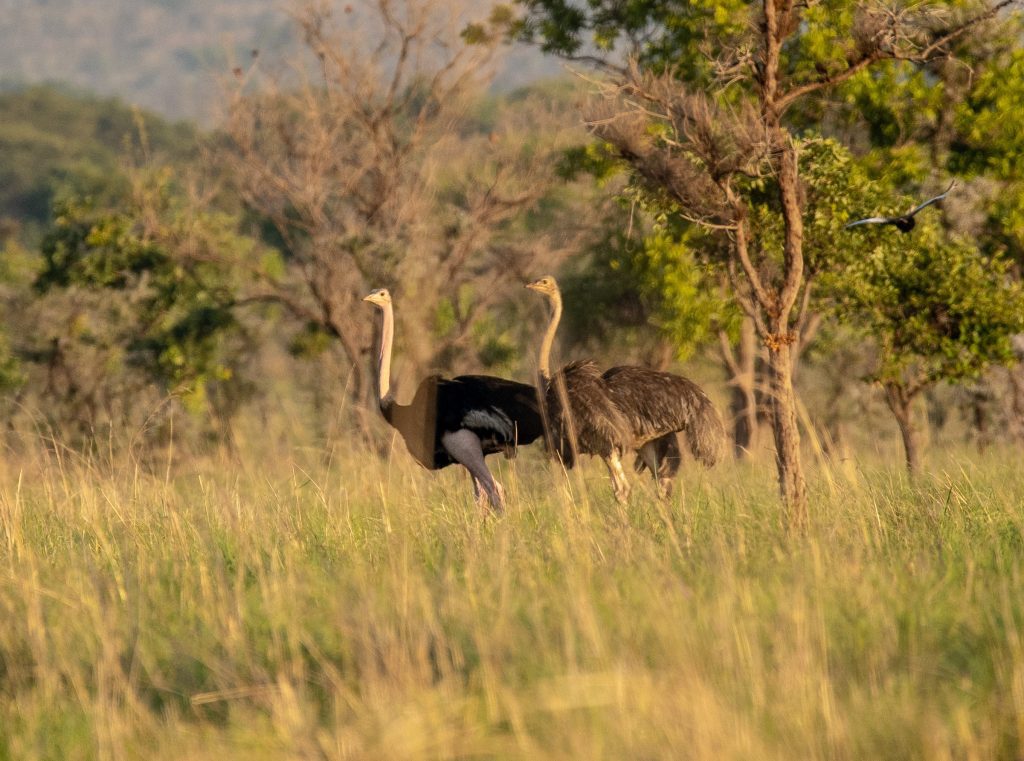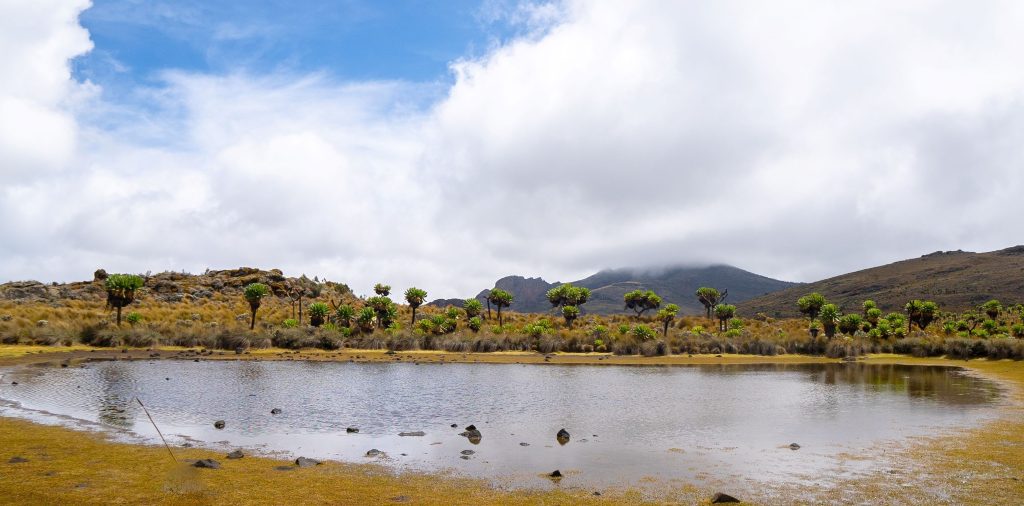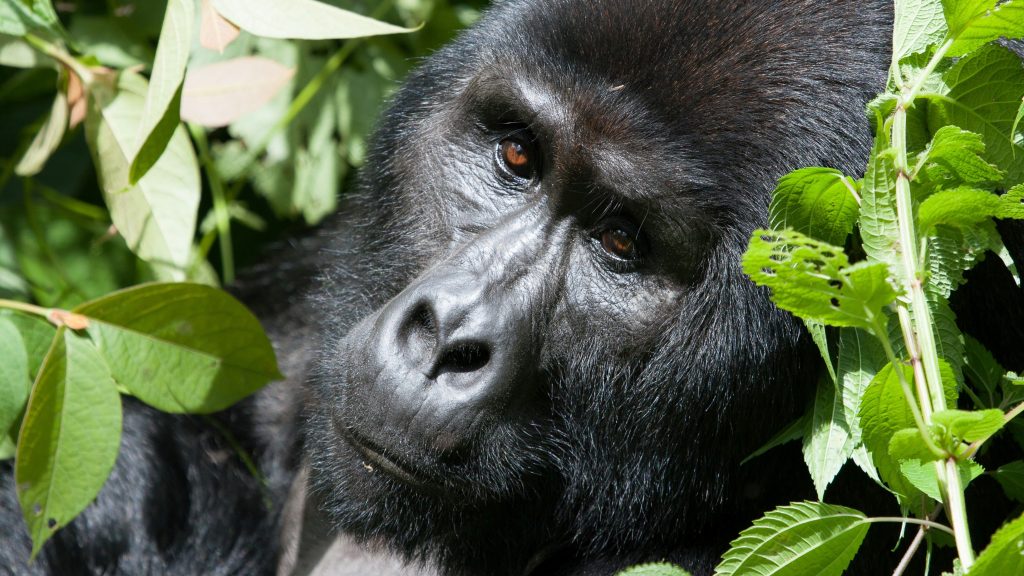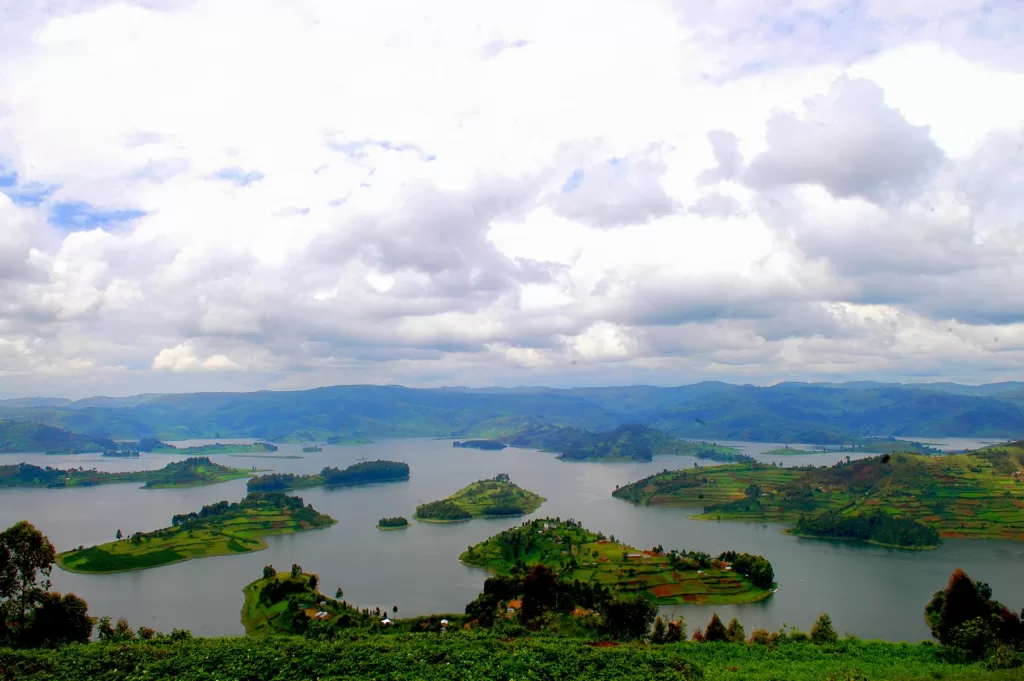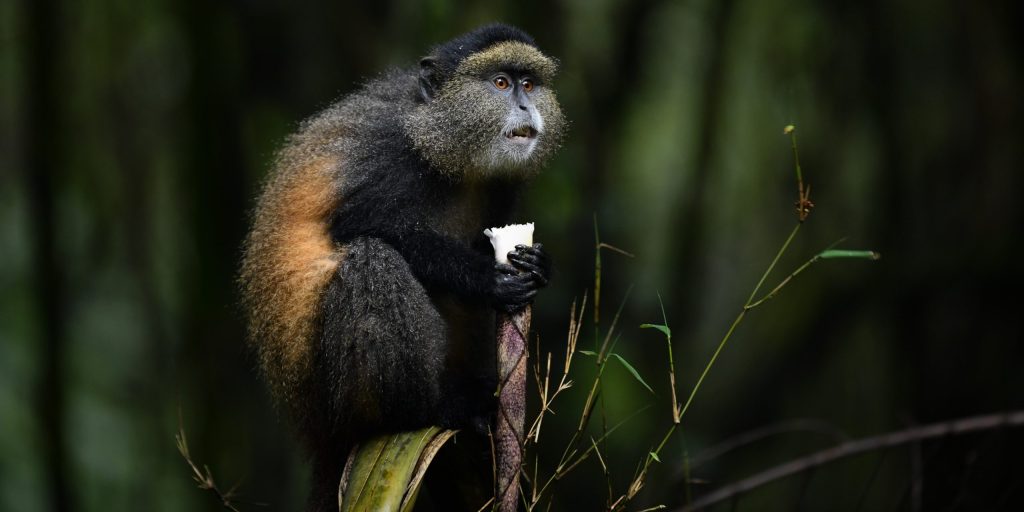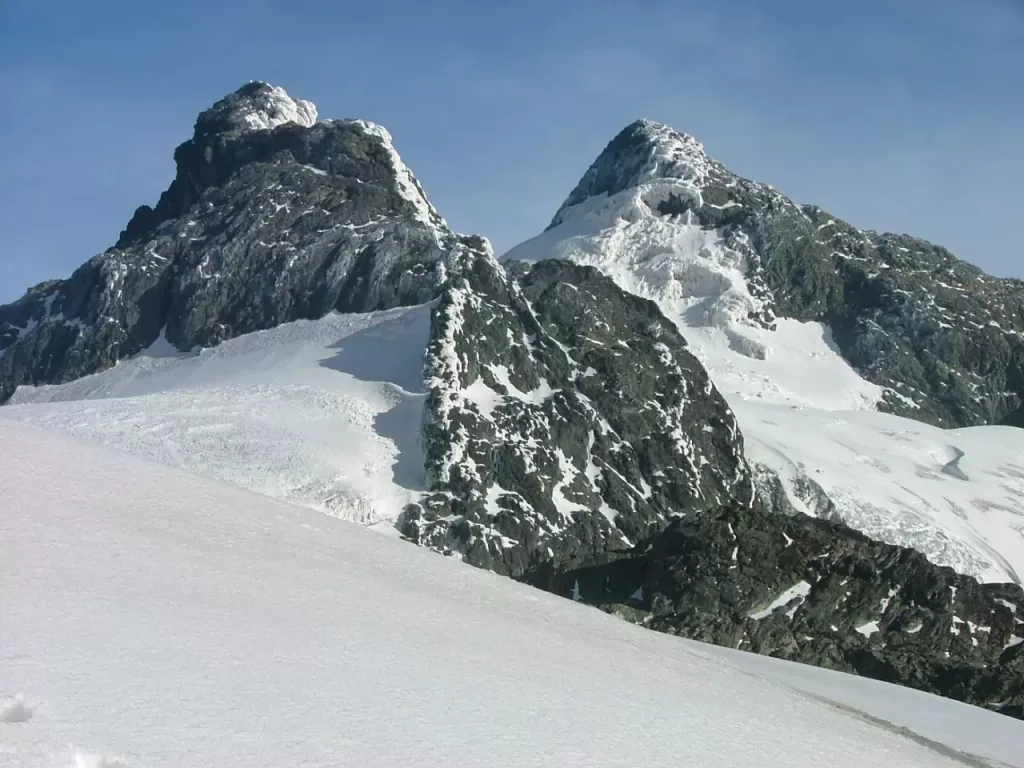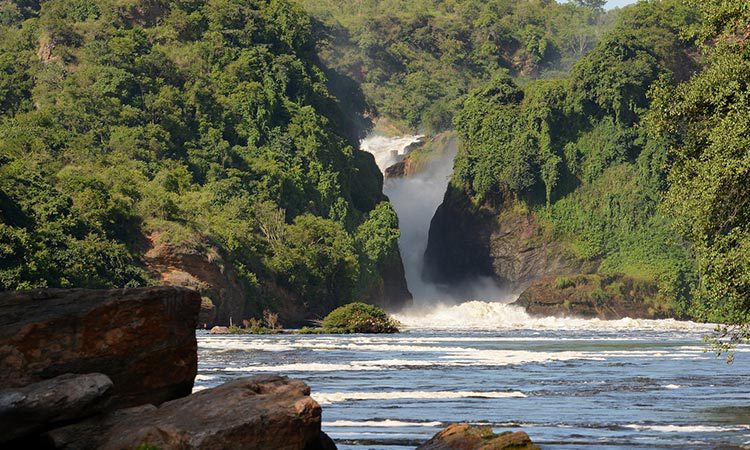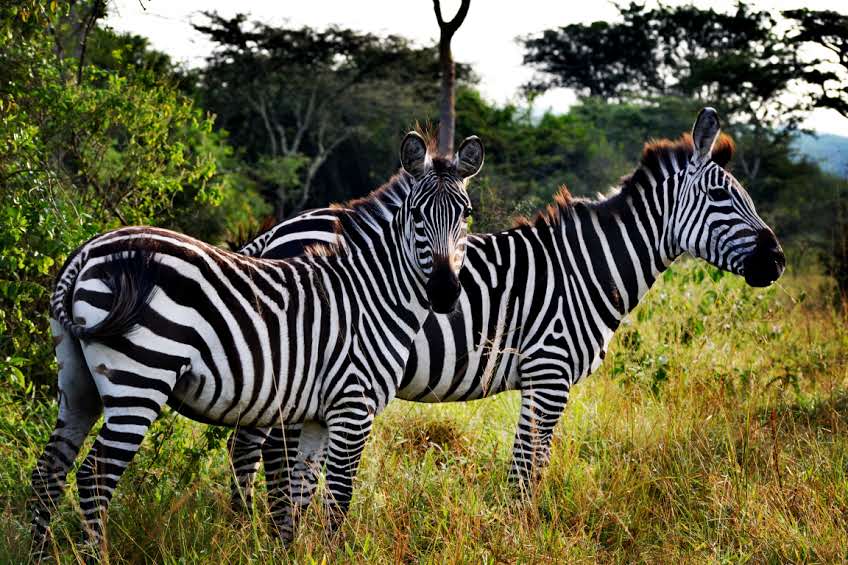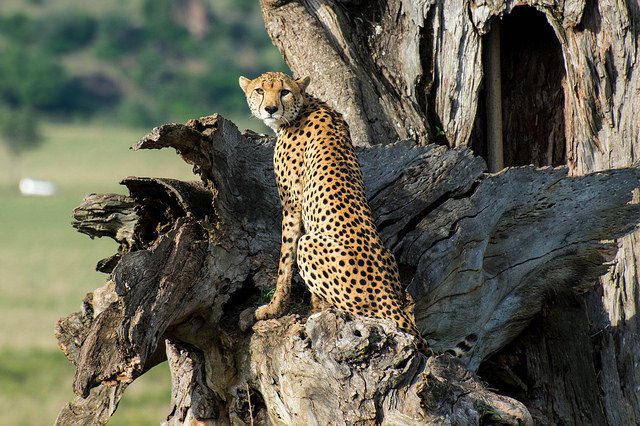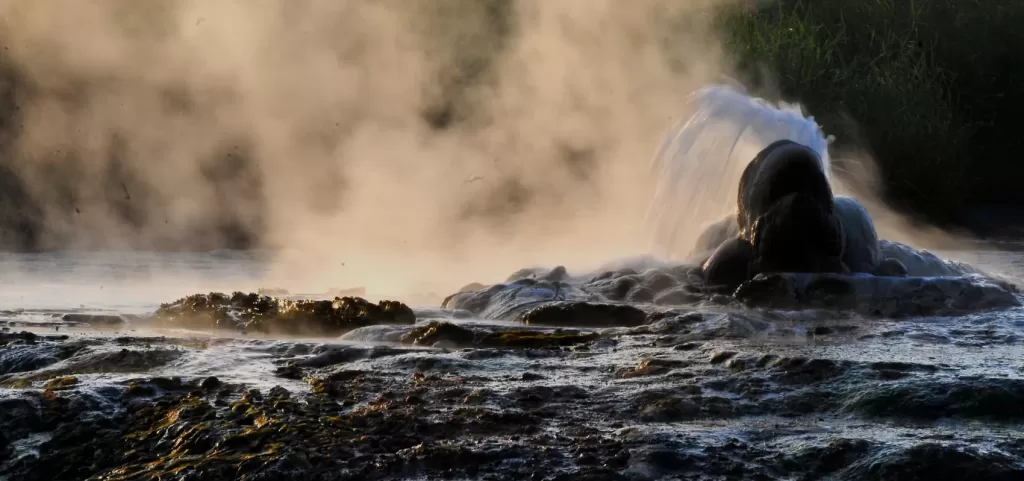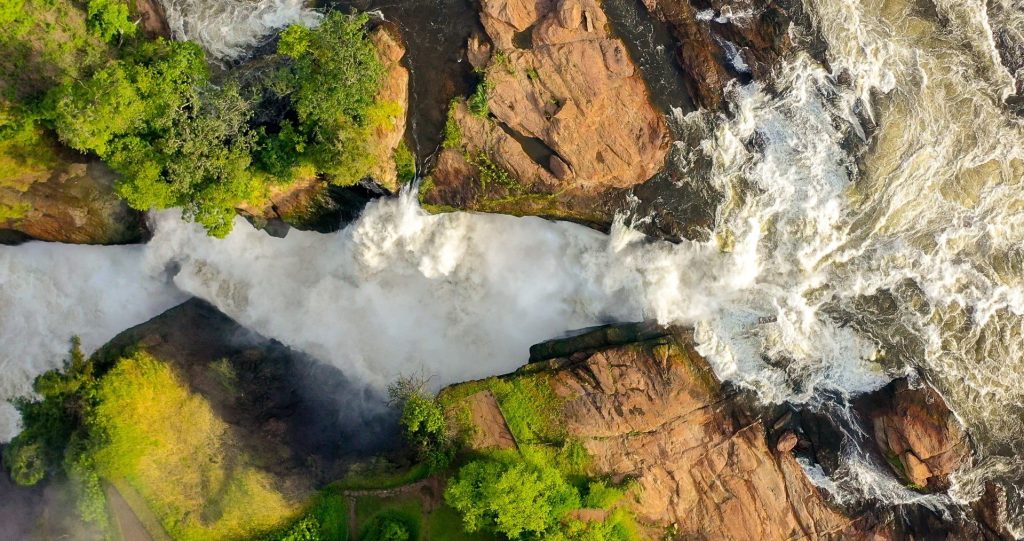
Queen Elizabeth National Park – Nature’s Grand Symphony
Nestled in the stunning western rift valley of southwestern Uganda, Queen Elizabeth National Park (QENP) spans Kamwenge and Kanungu districts, covering 1,978 square kilometers.
Globally renowned for its rich biodiversity, it stands out as Uganda’s top game-viewing destination.
QENP is surrounded by a variety of geographical features. To the west, the Ishasha River and Lake Edward form its boundary along the Congolese border, while Kasese and the Rwenzori foothills define its northern border.
To the east, it is bordered by Lake George, the Kyambura Gorge, and the Kalinzu Forest Reserve, with the Kigezi Wildlife Reserve to the south.
Split into two sections, QENP offers diverse ecosystems and wildlife experiences. The northern Kasenyi Plains feature expansive savanna plains bathed in equatorial sun.
Yet, the southern Ishasha Sector is famed for its unique landscape and iconic tree-climbing lions. With approximately 40 lions spread across three prides, this population adds intrigue to the park’s varied ecosystem.
For adventurers and nature enthusiasts, Queen Elizabeth National Park beckons with its unmatched beauty and abundant wildlife encounters.
The Park
Top things to do in Queen Elizabeth National Park
Game viewing / Wildlife drives in Kasenyi and Ishasha Sector
Discover the wonders of Kasenyi Savannah Plains in Queen Elizabeth National Park. Encounter Uganda Kobs, elephants, and warthogs amidst lush green and golden savannahs. Bird enthusiasts will be enthralled by diverse avian life, while predators prowl for their prey.
Embark on a journey through Kasenyi, North Kazinga Plains, and the Ishasha Sector for guaranteed sightings of buffaloes, antelopes, elephants, and lions, including elusive leopards along the Leopard track.
Embark on a thrilling adventure in Ishasha, where you’ll witness the rare sight of Tree-climbing lions. Marvel at these majestic creatures lounging on fig tree branches, creating unforgettable memories. Ishasha guarantees an African safari experience like no other with its unique landscape and abundant wildlife.
Kazinga Channel Boat Cruise
Experience the breathtaking vistas from the Mweya Peninsula as it gracefully merges with the tranquil waters of Lake Edward via the scenic Kazinga Channel. Spanning 32 kilometers, this natural watercourse seamlessly links the eastern Lake George with the western Lake Edward.
Originating from the Rwenzori Mountains, Lake George pours its waters into the Kazinga Channel, which, in turn, feeds into the expansive Lake Edward, renowned as one of Africa’s largest freshwater lakes, sprawling over 2,000 square kilometers.
Embark on a journey through the channel and immerse yourself in the diverse wildlife sanctuary of Queen Elizabeth National Park. Witness a captivating array of terrestrial, aquatic, and bird life in their natural habitat.
Join our daily 2-hour launch trips, departing at 9:00, 11:00, 15:00, and 17:00, for an opportunity to encounter over 60 species of birds. Look out for the majestic presence of hundreds of hippos, buffalo, and elephants dotting the shoreline, making every moment an unforgettable wildlife spectacle.
Chimpanzee tracking in Kyambura Gorge.
Nestled within Queen Elizabeth National Park’s eastern expanse, Kyambura Gorge is traversed by the Kyambura River. Plummeting 100 meters deep and stretching 16 kilometers beneath the Kichwamba region, it widens to one kilometer at its broadest point. Known as the ‘Valley of Apes,’ it houses around 15-20 habituated chimpanzees.
Famed for its diverse primate population, including black and white colobus monkeys, vervet monkeys, olive baboons, and red-tailed monkeys, the gorge offers captivating chimpanzee and nature walks lasting from 2 to 4 hours.
Chimpanzee tracking occurs in two sessions, starting with a morning session at 8:00 and followed by an afternoon session at 13:00, departing from Fig Tree Camp. However, chimp sightings aren’t guaranteed due to the limited number of habituated primates.
Birdwatching safaris in the park.
Nature Walks at the Maramagambo Forest
Discover the enchanting Maramagambo Forest with guided nature walks lasting 2 to 6 hours, perfect for bird enthusiasts and nature lovers.
Explore four distinct trails focused on forest conservation and wildlife discovery:
- Waterfall Trail: Immerse yourself in a 4-hour journey covering 11 kilometers of undulating terrain, culminating in the stunning Kilyantama waterfall.
- River Trail: Trek for 1 to 2 hours along the Kajojo River, encountering primates like L’Hoest’s monkeys, Vervet monkeys, and baboons, amidst lush greenery.
- Forest Trail: Ideal for hiking enthusiasts, this trail offers scenic landscapes, flowing rivers, primate encounters, and diverse bird and tree species.
- Valley Trail: Enjoy a 2-hour exploration along the ridge to discover the majestic Viagra tree, or opt for the leisurely 5-kilometer Palm Trail unveiling treasures like towering Raphia palms and enchanting dragon trees.
Community-Based Tourism Projects
Kikorongo Women Community (KWC)
Kichwamba Escarpment Community Tour
The program brings real-life experiences to tourists while enabling the local community to develop income-generating tourism-related ventures that safeguard their traditions and preserve the local environment.
Katinda Cliff and Twin Lakes
Kasyoha- Kitomi Forest Trail
Escape the ordinary and venture into the enchanting Kasyoha-Kitomi forest for a guided 3-hour hike. Keep an eye out for primates like chimpanzees, blue monkeys, red-tailed monkeys, black and white colobus, vervet monkeys, and baboons.
Additionally, the reserve features breathtaking crater lakes, including the twin lakes of Kamweru and Kyema, along with the mesmerizing “transparent” lake Kamunzuku.
Indigenous Tree Conservation Program.
You will have a chance to plant your tree on land adjacent to the Kasyoha-Kitomi Forest Reserve. This program aims at preserving and re-establishing indigenous trees that are of great benefit to the community, as some are of medicinal value.
At the Kichwamba Foundation
You may participate in other community activities, including a coffee tour experience learning about the processing of coffee, Local beer brewing, and Tasting, Local food preparation and tasting, and Cultural Traditional Dances.
Crater Lakes Explosion Tours
Three primary focal points stand out: the Katwe Explosion Craters nestled within Queen Elizabeth National Park, the adjacent Bunyaraguru Crater Field perched on the magnificent Kichwamba escarpment, and the enchanting Ndali-Kasenda Crater Field near Kibale National Park.
Among these, the vast Kyemengo Crater within the Katwe Explosion Craters steals the spotlight.
Located just north of the impressive Mweya Peninsula, these sites boast the highest elevations within the national park. Embark on the breathtaking Crater Drive spanning 27 kilometers, offering panoramic views of the picturesque crater lakes along the way.
The drive promises abundant wildlife sightings, with buffalo and Elephants being the most common. The Lake Nyamunuka crater drive, spanning about 2 hours, treats visitors to glimpses of buffalo herds.
Look out for Lake Kitagata, a serene lake fed by saline hot springs, devoid of wildlife but exuding unmatched beauty.
As you traverse this route, you’ll be treated to vistas of the grand Western Rift Valley and its escarpments, Lake George, the Rwenzori Mountains of the Moon, the Kazinga Channel, and Lake Edward.
Don’t miss the opportunity to explore the stunning Lake Katwe and its historic salt works along the journey.
Katwe Salt Lake
Standing as a unique spectacle in East Africa, Lake Katwe is among the rare salt lakes in the region. During the dry season, it becomes a focal point when communities gather to extract salt from its milky waters. Despite its high salinity, the lake is devoid of wildlife.
This traditional salt mining practice, which has endured for centuries, continues in Katwe, predominantly by hand. Although alternative sources and techniques have emerged, the salt harvested from Lake Katwe still forms a significant portion of the supply used in Ugandan households.
Visitors to the salt mines have the opportunity to delve into the intricacies of the salt mining industry while engaging with the local mining community. Most of the salt finds its way to manufacturers, with miners retaining a portion for personal use.
Adjacent to Lake Katwe lies the avian sanctuary of Lake Munyanyange, where the captivating sight of lesser and greater flamingos can be observed from August to November.
Wildlife Conservation and Research Tours
Queen Elizabeth Park provides opportunities for Wildlife Research Tour Projects, encompassing activities such as Lion Tracking, Mongoose Tracking, Hippo Census, and Bird Species Counts.
Participants engage in monitoring various bird species and mammals using locator devices, such as radio collars, while gaining insights into animal habituation calls and behaviors.
Accompanied by researchers and ranger guides, tourists observe as researchers record data for various projects, occasionally participating in animal censuses.
Where to stay in Queen Elizabeth National Park
Elephant Plains Lodge
Perched 941m above sea level on the western escarpment of the Albertine rift in the northeastern part of the park, the lodge provides panoramic views of the open grasslands stretching to Lake George.
Additionally, it offers 6 double/twin ensuite cottages and 2 family cottages with 2 bedrooms and 2 bathrooms. Moreover, all 10 cottages boast spacious verandas with stunning park views.
Furthermore, guests can enjoy various facilities, including a lounge, bar, restaurant, dining room with a spacious deck, swimming pool, gardens, nature trail walkways, craft shop, free WIFI, wheelchair accessibility, and an open-top game vehicle.
Mweya Safari Lodge
The lodge is located on the Mweya Peninsula and features 16 Classic Guest Rooms, 28 Deluxe Guest Rooms, 2 Wheelchair Friendly Guest Rooms (including Classic rooms), 2 Suites, 2 Safari Tents, 2 Family Cottages, the Queen’s Cottage, the Presidential Cottage, and Queen’s Pavilion Conference Facilities.
Other facilities include Marasa Africa Spa, Fitness Centre, Poolside deck overlooking the Kazinga Channel, Gift Boutique Store, Business Centre, Kazinga Restaurant, and Terrace.
Furthermore, there is the Tembo Bar, the Poolside deck overlooking the Kazinga Channel, and the Bush Dining in Queen Elizabeth National Park.
Buffalo Safari Lodge
The Lodge is located at Queen Elizabeth Park, Katunguru Bridge, near the magical Kazinga channel, 1km off the Kasese-Mbarara road, Western Uganda.
The lodge offers a total of 17 rooms, including both standard and deluxe cottages. Each room is thoughtfully designed to maximize the spectacular views of the surrounding landscape while providing a cool retreat from the scorching savannah heat of Queen Elizabeth National Park.
From the bed to the sitting area and even the upper balcony, guests can enjoy uninterrupted vistas and refreshing comfort.
Other facilities include a restaurant and dining room, a lounge and bar area, a swimming pool, and a large terrace overlooking the park.
Bush Lodge
The lodge has 12 en-suite bandas and two safari tents for an authentic bush experience. 10 non-self-contained tents are budget-friendly.
Furthermore, the tents have comfortable beds and power outlets. Guests can enjoy a starlit shower in the ensuite bathroom that has an outdoor shower. The lodge also has a large dining tent and a bar area for guests to enjoy.
Ishasha Wilderness Camp.
The camp is located in the Southern Ishasha sector of Queen Elizabeth National Park, on the Ntungwe River. It is home to the famous tree-climbing lions.
The camp has eight Safari tent-styled rooms, each of which has a private verandah that overlooks the river. The tents are all en-suite and comfortably furnished with large mosquito-netted beds.
They also have hot “bush” showers, running water for the hand basins, and a flushing “eco-friendly” toilet.
Other amenities at the camp include a thatched central lounge and dining area, a campfire area, bush dining, sundowners, and a gift shop.
The best time to visit Queen Elizabeth National Park
Experience the Park’s two distinct seasons: the dry and the wet. During December to March and June to August, the dry season prevails, bringing scarcity of water.
This scarcity draws wildlife closer to reliable sources and thins out vegetation, enhancing wildlife viewing.
In contrast, the wet or green season from April to May and September to November welcomes increased rainfall. This results in lush greenery but fewer animal sightings.
Yet, it’s the prime time for migratory bird watching. This season offers stunning landscapes for photography and often discounted lodge rates.
For travelers in pursuit of optimal weather conditions, June to September is the sweet spot. Boasting low rainfall and abundant food sources, it’s perfect for bird watching.
How to get to Queen Elizabeth National Park.
Approximately 410 km west of Kampala, Uganda’s capital, lies Queen Elizabeth National Park. Travelers can reach it via a 7 to 8-hour drive, enjoying scenic views along the way.
Alternatively, flights from Entebbe International Airport (EBB) to airstrips in Kasese, Mweya, or Kihihi (for Ishasha) offer a quicker option.
Furthermore, the aerial route provides a stunning perspective of Uganda’s landscapes, enhancing the safari experience.[/vc_column_text]
Other Uganda Destinations
ABOUT TRAVELERS LINK AFRICA
Our mission at Travelers Link Africa is to connect people to positive travel experiences, enabling them to see the world differently, transforming lives and the communities visited.
To do this we offer authentic travel experiences taking you on both an outer adventure and an inner journey to create memories of a lifetime with Uganda, Kenya, Tanzania, and Rwanda
GET SOCIAL WITH US
Follow our Travelers Link Africa adventures and share your own with us
CONNECT WITH US
We’re here to help, so get in touch with our friendly travel consultants to book your package or add customizations to your safari
Our main phone number is
+256 754 062 366
– OR –
